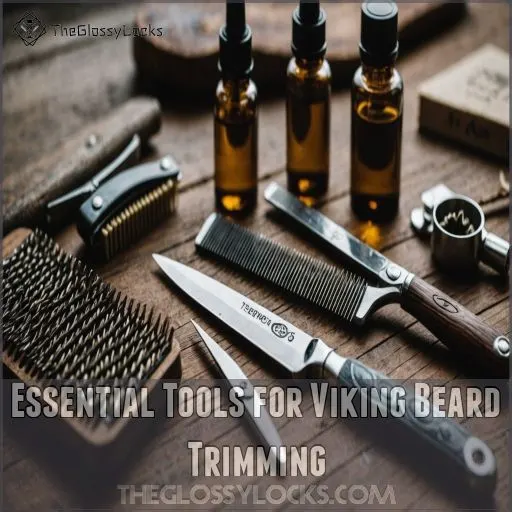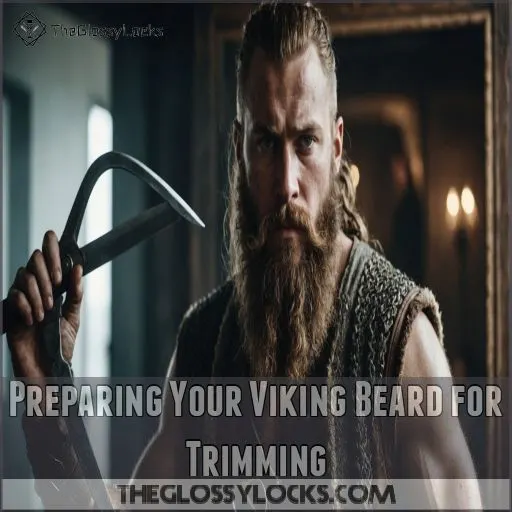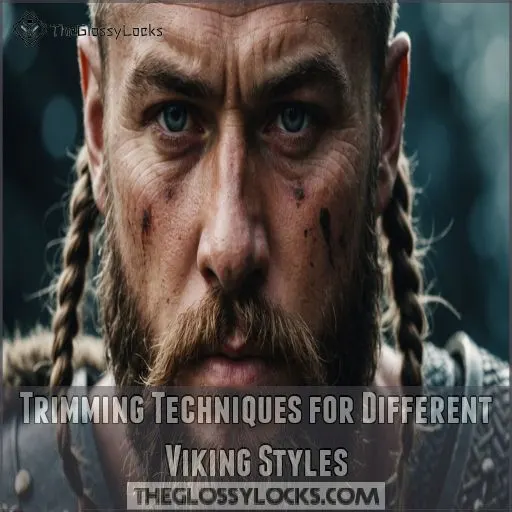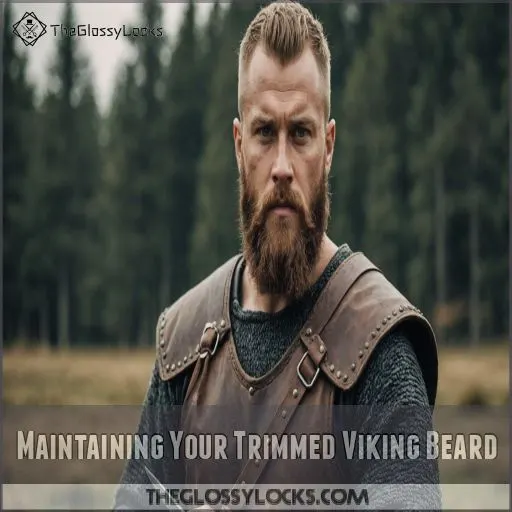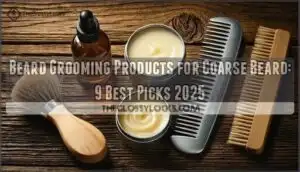This site is supported by our readers. We may earn a commission, at no cost to you, if you purchase through links.
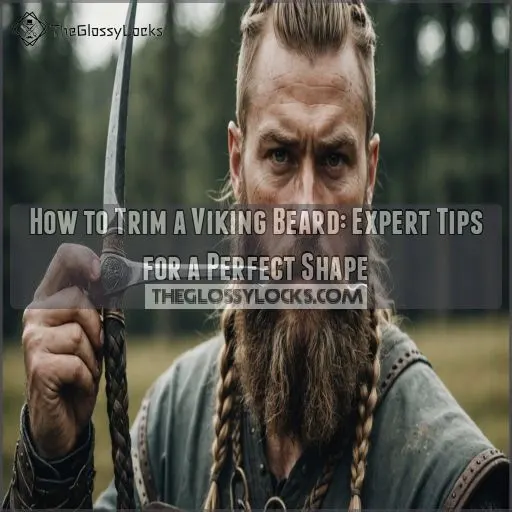 Trimming a Viking beard is like sculpting a masterpiece—it’s all about the right tools and techniques.
Trimming a Viking beard is like sculpting a masterpiece—it’s all about the right tools and techniques.
Grab a quality beard trimmer and scissors to start.
Detangle those mighty locks with a wide-toothed comb, and treat them to some nourishing beard oil and balm, making even Thor envious.
Achieve the perfect look with precision trimming attachments and a touch of styling products.
Wash, dry, and comb your beard to prepare for the trim, ensuring those uneven spots are tamed.
Crush those face-shaping goals and keep your bushy glory maintained.
Ready for more beard-crafting secrets?
Stick around for expert tips ahead!
Table Of Contents
Key Takeaways
- Start with the right gear, like a top-notch beard trimmer, scissors, and a trusty wide-toothed comb. These tools are your beard’s best friends—no one wants a trimming disaster! Think of them as the hammer and chisel for your face’s glorious sculpture.
- Treat your beard like royalty! Add some beard oil and balm to your daily ritual, transforming those rugged locks into soft, shining glory. Not only does it make Thor jealous, but it also helps detangle and tame those mighty bristles.
- Before your trimming escapade, ensure your Viking beard is clean and prepped. Wash with warm water—no need for a hot sauna! Then, gently pat it dry. A little detective work with your comb helps spot any uneven growth ready for some snipping action.
- Embrace your inner Norse warlord with style variety! Whether you’re aiming for the full and bushy warrior vibe or a sleek, modern Viking look, precision trimming is your ally. Tap into different styles like braided or faded cuts to keep your beard adventurous and legendary.
Essential Tools for Viking Beard Trimming
To achieve the perfect Viking beard, you’ll need the right tools in your grooming arsenal.
From a quality beard trimmer and sharp scissors to a wide-toothed comb and nourishing beard oils, these essential items will help you shape and maintain your majestic facial hair like a true Norse warrior, just like the tips for beard growth suggest. (Source)
Quality Beard Trimmer and Scissors
Getting a grip on the right tools for Viking beard trimming is half the battle won.
Opt for top-rated brands with sharp blades that promise cordless convenience.
A quality trimmer cuts like a hot knife through butter, while robust scissors offer precision.
No one’s got time for dull tools, so maintain them well—don’t let your beard wield the sword!
Wide-toothed Comb for Detangling
So, after you’ve got your trimmer and scissors ready, don’t overlook the power of a wide-toothed comb.
This tool is a game changer for detangling knots in your rugged Viking beard.
Choose a comb size that suits your beard’s thickness, ensuring smooth strokes.
Beard Oil and Balm for Conditioning
Think of beard oil and balm as superpowers for your Viking beard, keeping it lush and tamed.
Explore the world of beard oil benefits!
Choose the right oil for smoothness and shine, while balm locks in moisture and style.
DIY beard oil adds a personal touch, offering mastery over your beard’s fate and appearance.
Precision Trimming Attachments and Guards
For precision trimming, the right attachments and guards are essential.
Look for a trimmer with a variety of guard sizes to achieve your desired beard length – from a close, clean-shaven look to a rugged, full-bodied Viking style.
Opt for sharp, high-quality blades that glide through your beard effortlessly, minimizing irritation and ensuring a clean, even trim.
Styling Products for Shaping and Hold
| Product Type | Hold Strength | Natural Options |
|---|---|---|
| Beard Wax | Strong | Beeswax-based |
| Pomade | Medium | Essential oils |
| Styling Sprays | Light | Aloe-infused |
Experiment with these to effortlessly achieve that legendary, rugged look.
Natural options for beard styling include beeswax-based products, essential oils, and aloe-infused styling sprays.
Preparing Your Viking Beard for Trimming
Before you trim your Viking beard, it’s essential to prepare it properly to avoid any hairy disasters.
By washing and conditioning your beard, detangling the thick strands, and surveying its length with a touch of pre-trim oil, you’ll set the stage for a beard that’s epic and well-behaved.
Washing and Drying Techniques
Before you show off your inner Viking, make sure your beard’s ready for battle with proper washing and drying techniques.
Use these tips:
- Water Temperature: Go for warm water, never scalding hot.
- Beard Shampoo: Choose one that suits you.
- Conditioning Routine: Moisturize with a reliable conditioner.
- Towel Drying: Gently pat, don’t rub, to avoid frizz.
Embrace the strength of a well-prepped beard!
Detangling Long, Thick Beards
Your long, lush Viking beard is a badge of honor, but those pesky tangles can be a real hassle. Fear not, brave warrior! With the right detangling tools and techniques, you’ll have that mane tamed in no time.
Grab a wide-tooth comb and gently work through any knots, starting from the ends and working your way up. A few drops of natural beard oil can also work wonders to smooth and soften those unruly strands.
| Tool | Technique | Benefit |
|---|---|---|
| Wide-tooth Comb | Start at ends, work up | Detangles gently |
| Beard Brush | Brush in direction of growth | Smooths and distributes oils |
| Beard Oil | Apply to damp beard | Conditions and softens |
Applying Pre-trim Beard Oil
Long, thick beards need extra care, so don’t skip that beard oil! It’s your secret weapon for a smooth, easy trim. With oil’s magic touch, even the most unruly beard becomes manageable.
Trust in this pre-trim prep:
- Choose wisely: Different oils for different needs.
- Warm it up: Rub between palms.
- Massage gently: Cover every strand.
- Don’t overdo: A few drops go far.
Combing to Identify Uneven Areas
When combing, think of yourself as a detective sifting through clues of uneven growth.
Use a wide-toothed comb to reveal split ends and spot pesky pitfalls.
A mirror is your trusty sidekick—don’t skip it.
Observe beard growth patterns, dodging trimming mistakes that lead to wonky shapes.
Look closely; every stroke reveals secrets hiding in plain sight!
Determining Desired Length and Shape
As you comb through, those uneven areas will speak to you.
Now, ponder your beard length preferences and draw inspiration from classic Viking beard styles. Consider your face shape for the perfect beard shape. Maybe a bushy warrior look suits you, or a sleeker style?
Let your desired beard look guide your trimming journey, balanced and bold.
Trimming Techniques for Different Viking Styles
Achieving the perfect Viking beard style requires a bit of trimming know-how.
Whether you’re going for a full and bushy Norse warrior look or a neat and sculpted modern Viking appearance, the right techniques can help you shape your facial hair with precision.
Full and Bushy Norse Warrior Look
You’ve identified uneven areas and now it’s time to embrace the spirit of a Norse warrior.
Let your beard grow wild and proud—like Odin himself would approve.
Use quality trimming tools and beard oil to tame that fierce mane.
Master the art of braiding and dispel old beard grooming myths.
Neat and Sculpted Modern Viking Appearance
While the full Norse look is the bear in the woods, the neat and sculpted modern Viking beard’s more your stylish wolf.
Grab that trimmer like a knight his sword; precision is your ally.
Trim evenly, keeping an eye on those cheek contours.
With trendy Viking beards, less is sometimes more, championing crisp lines and exact lengths.
Long, Braided Beard Styles
Switching gears from the neat modern look, let’s embrace that legendary Viking vibe.
Long, braided beard styles ooze history and mastery.
Here’s the scoop:
- Braiding Techniques: Master different braid patterns for a unique flair.
- Beard Care: Use oils to prevent tangles.
- Accessories: Add beads for personality.
Massage your inner Viking; wield power with style!
Short, Rugged Viking-inspired Cuts
For a rugged, modern Viking look, opt for a short, faded beard style.
Start by trimming the sides and neckline close to the skin, then gradually blend the length in the direction of the chin.
Use a quality beard oil to keep the look sleek and tidy.
This low-maintenance style exudes an effortless, masculine vibe.
Maintaining Mustache Length and Shape
So you’ve conquered the short, rugged Viking look—now let’s tackle that mighty mustache!
Keep it majestic by focusing on:
- Trimming tools: Snip with precision.
- Mustache styles: Groom for your grandeur.
- Beard oil benefits: Adds shine and softness.
Treat it like a warrior’s helmet: maintain with pride and never let it overshadow your beard’s mightiness!
Shaping Your Viking Beard to Face
Matching your Viking beard to your face can feel like picking the right helm—it either fits perfectly or slides off completely.
By considering your jawline and cheekbones, you can achieve a look that makes even the fiercest Norse gods proud.
Complementing Square Jaw Structures
To shape your Viking beard for a strong square jaw, picture a sculptor perfecting a masterpiece.
Aim for jawline definition by trimming to highlight your jaw’s bold lines.
Balance beard shape by emphasizing angularity with those trusty sideburns and blend the neckline seamlessly.
It’s like sharpening a blade—precision matters, but so does the artistry of your hand!
Enhancing Round Face Shapes
If you have a round face, a well-trimmed Viking beard can be a game-changer. Here’s how to enhance your features:
- Trim sideburns to just below the ear for a defined jawline.
- Keep the beard length moderate, avoiding excessive fullness that can overwhelm a round face.
- Sculpt the cheek line to create a slimming effect.
- Use beard oil and balm to tame flyaways and add shine.
- Maintain a balanced density throughout for a polished, masculine look.
Balancing Oval and Oblong Faces
For balancing oval and oblong faces, think of your Viking beard as armor.
Keep sideburns well-trimmed to avoid conquering your cheek lines.
A defined neckline shaping helps maintain a strong jawline shape.
Experiment with beard length to highlight facial strength without overwhelming it.
Your face is your battlefield; make sure your beard complements it, not commands it!
Defining Chin Lines and Cheek Contours
Now, let’s nail that Viking look by defining cheekbones and shaping your jawline with precision.
Razor or trimmer? Go with what feels right for you.
When trimming sideburns, keep things even. Unevenness is nobody’s friend.
A little care can turn that noble mane into a masterpiece, making your beard a banner of mastery and power!
Creating Symmetry With Asymmetrical Features
Balancing chin lines and cheek contours is like painting a masterpiece, and here’s how you can handle asymmetrical features. Facial asymmetry isn’t a deal-breaker; use beard shaping tricks to create visual illusions.
Consider:
- Emphasize stronger hair growth patterns.
- Trim to add natural balance.
- Spotlight symmetry with light styling.
Maintaining Your Trimmed Viking Beard
Maintaining your trimmed Viking beard requires a consistent grooming routine.
From daily brushing to weekly deep conditioning treatments, these simple steps will keep your beard looking its best between major trims.
Daily Grooming Routines
Every morning, kick-start your day with a robust beard wash routine.
Use targeted beard comb styles to untangle and sculpt your mane.
Beard oil benefits shine in a daily ritual, promoting hydration and sheen.
Swap brushes on occasion—a firm brush for shape, a soft one for sheen—and finish with beard balm for a conquering look.
Weekly Deep Conditioning Treatments
Regular deep conditioning is key to a Viking beard that’s both impressive and manageable.
Every week, apply the best beard conditioners; they soften and strengthen hair.
Want to save a buck? DIY conditioner recipes using coconut oil are your ticket to success.
Apply with your fingertips, massaging those bristles lovingly.
Touchup Trimming Between Major Cuts
You’ve been deep conditioning like a pro, so now let’s talk about those touchup trims. It’s all about maintaining that Viking majesty without over-trimming.
Focus on using beard balm and the right tools to tame strays, especially around the neckline.
Happy sculpting, fearless beardsman!
Addressing Split Ends and Flyaways
Pesky split ends and flyaways can ruin your carefully trimmed Viking beard. Blame dry skin, harsh weather, or over-styling.
Tame them with a boar bristle brush to distribute natural oils. Massage in some beard oil to nourish and smooth strands.
Finish with a touch of wax or balm to keep flyaways at bay. Your beard will look rugged yet refined.
Seasonal Adjustments for Beard Care
Don’t let beard struggles cloud your Viking vibe.
Winter beard dryness needs rich, hydrating oil, while summer demands sun protection.
Fight fall beard itch with calming balms, and in spring, boost growth with invigorating formulas.
Explore seasonal beard oil options, ensuring a beard for all seasons.
Frequently Asked Questions (FAQs)
How often should I trim my Viking beard?
Like taming a wild beast, trim your Viking beard every couple of weeks.
This keeps it as fierce as a Norse god.
Monitor your beard’s growth and adjust accordingly, ensuring it remains majestic and well-groomed.
What are the best products for Viking beard care?
You’ve got the heroic beard, now treat it like royalty!
Use beard oils with argan or jojoba,
a boar bristle brush to tame the wild mane,
and beard balm to sculpt it into a masterpiece worthy of Odin.
How do I prevent split ends in my Viking beard?
To tackle split ends in your Viking beard like a maestro, gently wash and condition regularly.
Apply nourishing beard oils and schedule routine trims.
Treat it like a gentle giant, providing care and respect to keep it mighty.
Can I dye or color my Viking beard?
Coloring your Viking beard can be a bold statement, but take care – harsh dyes may damage delicate facial hair.
Opt for gentle, natural hues and always do a patch test first. (Source)
What is the ideal length for a Viking beard?
Grow a beard that’s at least 5 inches to dominate the world with fierce style! Anything shorter just won’t cut it for achieving that legendary look of Norse mythology! (Source)
Conclusion
Imagine your Viking beard as a majestic forest that needs regular pruning to thrive.
By following these expert tips, you’ve mastered how to trim a Viking beard with precision and flair.
Armed with the right tools and techniques, you’re ready to conquer any beard style you desire, from the wild Norse warrior to the polished modern Viking.
Keep your Viking beard looking its best with routine maintenance, and watch how it shapes the very essence of your bold identity.

